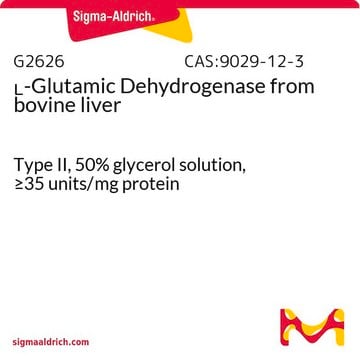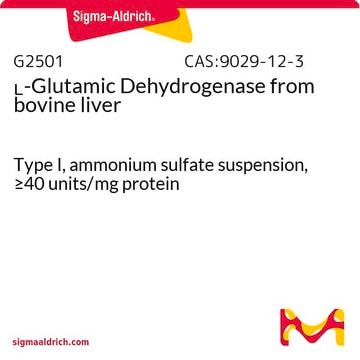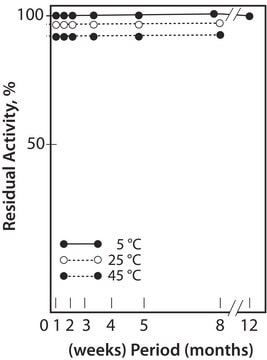10197734001
Roche
Glutamate Dehydrogenase (GlDH)
from beef liver
Sinonimo/i:
DNA marker
About This Item
Prodotti consigliati
Origine biologica
bovine liver
Livello qualitativo
Forma fisica
lyophilized
Attività specifica
10 U/mg
~10 units/mg protein (at 25 °C with 2-oxoglutarate as the substrate, and ADP as the activator.)
Confezionamento
pkg of 3,000 U
Produttore/marchio commerciale
Roche
Concentrazione
≥10-20 % (w/w)
tecniche
activity assay: suitable
Colore
white
pH ottimale
8
Solubilità
water: 20 mg/mL, colorless
Compatibilità
suitable for UV spectrophotometry and general use
N° accesso UniProt
applicazioni
life science and biopharma
Attività estranea
ADH <0.00500%
LDH <0.00500%
MDH <0.00500%
Condizioni di spedizione
wet ice
Temperatura di conservazione
2-8°C
Informazioni sul gene
bovine ... GLUD1(281785)
Categorie correlate
Descrizione generale
Applicazioni
Qualità
Sequenza
Altre note
Codice della classe di stoccaggio
11 - Combustible Solids
Classe di pericolosità dell'acqua (WGK)
WGK 1
Punto d’infiammabilità (°F)
does not flash
Punto d’infiammabilità (°C)
does not flash
Certificati d'analisi (COA)
Cerca il Certificati d'analisi (COA) digitando il numero di lotto/batch corrispondente. I numeri di lotto o di batch sono stampati sull'etichetta dei prodotti dopo la parola ‘Lotto’ o ‘Batch’.
Possiedi già questo prodotto?
I documenti relativi ai prodotti acquistati recentemente sono disponibili nell’Archivio dei documenti.
I clienti hanno visto anche
Il team dei nostri ricercatori vanta grande esperienza in tutte le aree della ricerca quali Life Science, scienza dei materiali, sintesi chimica, cromatografia, discipline analitiche, ecc..
Contatta l'Assistenza Tecnica.







